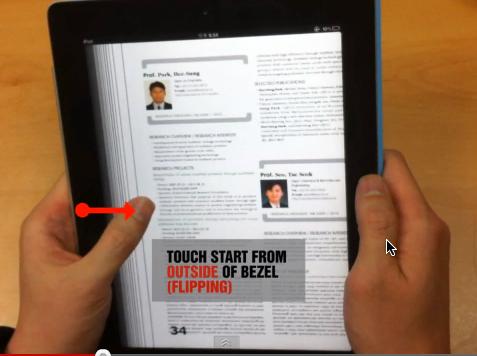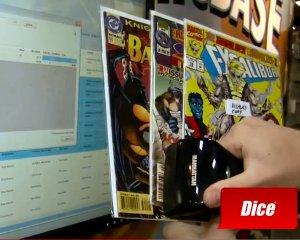
A design team from the Korea Advanced Institute of Science and Technology (KAIST) has developed a new e-reading system that is
designed to feel much more like reading a good old-fashioned paper book. The Smart E-book System, which can be incorporated into existing technology, makes use of the bezel of the device. Using what the designers have termed “algorithm based conversion technology,” the system converts movements between the screen and bezel into book-related actions such as flipping pages and bookmarking. If that does not sound terribly exciting, consider some of the following actions that the Smart E-book System is able to interpret:
- Placing a finger or thumb on the right side of the screen and then sliding it onto the bezel flips the page forward. If the finger or thumb is slid to the point that it is between the screen and the bezel then it will leaf through the book.
- Doing the same as above on the left side of the screen flips the pages back or continuously flips back.
- Flipping pages with multiple fingers will flip through a corresponding number of pages.
- Pressing for longer before sliding the finger also allows for the turning of multiple pages.
- Sticking a finger on one page bookmarks the page.
- If the user leaves a finger on a bookmarked page then he or she can keep turning pages and immediately access the bookmarked page by sliding that finger towards the bezel.
- If the user holds their finger in place on one page and finds another interesting page then they can flip between the two pages — cross-referencing if you will.
- Drawing a number on the screen will turn to that page.
The Smart E-book System can work on existing devices (obviously they need multi-touch), because it interprets the gestures that move off the screen. When reading a novel, I prefer to read on e-books. They are lighter, automatically bookmark your page, and they let you carry a whole library worth of reading material wherever you go. The trouble for using them as reference material has always been navigation – if you know that the page that you want to get to is somewhere in the middle, you can open the book to the middle and leaf back or forth to find the page. On an e-book, you would always have to open the menu and manually enter the page number, or go through page by page until you get to the end. It is a clunky way to move around. The KAIST system levels the navigation playing field and adds enough little extras to make going paperless, especially in the education sector, worthwhile. [youtube=http://www.youtube.com/watch?v=rVyBwz1-AiE&w=560&h=349]



